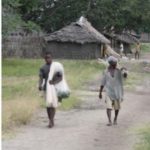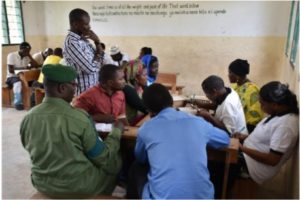
07 Dec Saadani National Park, Tanzania
Key Messages
Activities are underwayin the Saadani National Park area intended to result in:
- Involving communities in alternative, environmentally compatible livelihood activities that improve well-being for local residents.
- Improving the relationship between the management of Saadani National Park and the surrounding communities.
- Improving land management to arrest deforestation and ensure conservation of critical resource features both within and outside the national park.
Community Introduction
Tanzania’s Saadani National Park, established in 2005 with an area of 1,100 km2, is a coastal strip along the Indian Ocean north of Dar es Salaam. Within the national park system, Saadani is the only coastal park and is especially important for protecting rapidly diminishing coastal forests, the Wami River estuary and mangrove environments, along with a marine component of offshore coral reefs and turtle rearing beach(1).

Figure 1: Map of the Saadani Natinal Park in Tanzania
Four ecozones make up Saadani National Park: the marine environment of the Indian Ocean; the fresh water ecosystem of the major river courses; the coastal forests; and the humid savanna. The marine environment includes the breeding areas and habitat for over 40 fish species and significant populations of gastropods, echinoderms and corals. Mangrove forests and salt pans are located in the central and southern Saadani. Additionally, nesting beaches of the threatened green turtle are protected within the park. The Wami River and its corridor along the southern border of the area remains an important natural freshwater system especially in the river’s lower reaches. The coastal forest zone is critical for regulating the water cycle and provides habitat for a wide variety of mammals including elephants, leopards, kudu, suni, duiker, bush babies and Colobus monkeys. The humid savanna, including long grass, short grass and black cotton plains, supports grazers and browsers such as hartebeest, waterbuck, buffalo, and reedbuck.

Figure 2: Hippos in the Wami River, Saadani National Park (Photo Credit B.K. Downie)
The park was created from three major components of crown land which together comprised approximately 500 km2 of the total land area. Negotiations with villages of the area resulted in the remainder of the park being composed of former village lands(2,3). However, community residents do not believe that the benefit commitments made by the Tanzania National Parks Agency (TANAPA) in exchange for the land, such as employment and community services, have been realized(4). Furthermore disputes over the actual boundary of the park continue and remain extremely contentious(5). TANAPA wants to retain existing lands and believes that more land needs to be added to the park to ensure integrity of key resources(6).
The Saadani Community
The villages bordering Saadani National Park are small and subsistence livelihood based, with fishing dominating along the coast and agriculture taking over in inland communities. Services remain limited and public infrastructure is poor. The economies of the villages are very small and dominated by micro enterprises linked to and supplementing the production from subsistence agriculture and fishing.
Salt production is the only industrial activity in the immediate area although sisal plantations exist to the north and a sugar cane plantation is proposed in the southwest corner of the area. Tourist lodge facilities pre-dated the park and have expanded since park establishment, although by comparison to other national parks in Tanzania, both numbers of sites and park visitation remain relatively small(4).

Figure 3: Small business enterprise in Saadani village (Photo Credit B.K. Downie)
Conservation and Livelihood Challenges
Although relatively close to major population centres, the infrastructure of the Saadani, including water and power systems, transportation and communications, are not well developed due to the small and dispersed population. Local village economies remain very small with limited wage, employment, and public services such as education and health care.
The interaction between resource extraction and environmental change is the biggest challenge facing the Saadani. Species that have supported both human need and ecosystem function are being diminished or lost due to overharvesting, resulting in the associated impact on other species. For example, as fresh water fish stocks decline in the Wami River, the dependent bird and reptile species diminish as well. Population pressure leads to increased conversion of land to agriculture, which diminishes the coastal forest cover and impacts the water regime, which in turn impacts agricultural productivity.

Figure 4: Fisher in dhow off the coast (Photo Credit B.K. Downie)
Sensitive and vulnerable landscapes present significant challenges for conservation and management in the context of the Saadani and have been the focus of some of the conflict between the park and the communities. Coral reefs, as an example, have experienced considerable degradation. With the establishment of the park, a key reef and island complex was closed to community harvest. Mangroves, also highly impacted by human activity, are a priority for protection within the park and additional areas currently outside the park are a priority for acquisition.
Incompatible land uses also illustrate the conflict between conservation and community needs. A private sector salt producer currently operates in an enclave within the park and park management wants the operation closed and the area added to the park. However, the salt company is one of the few employers in the area and closing the operation would seriously impact potential wage employment for local people. Similarly, the most severe environmental impact in the area is the diminishing forest land which is being converted to agriculture or simply removed for the production of charcoal. This land use pattern will have an inevitable negative impact on the viability of the park unless the trend is reversed, yet land for agriculture and the energy and income resulting from charcoal production will be extremely challenging to replace.
Community Initiative
Given the above situation, there are great needs for:
- Community led activities that foster long-term sustainability of community based conservation and development initiatives.
- Support for local communities, both rural and urban, to understand the conservation values of the environment in which they live.
- Support for communities to implement development interventions that are compatible with and build on those natural resource values.
- Support for protected areas management agencies to work with local communities in the cooperative achievement of both protected areas and community objectives.

Figure 5: Fishers in Saadani village going to fish (Photo Credit B.K. Downie)
These activities have been undertaken by the Kesho Trust, a Canadian charitable organization (registered 2005) and also registered as a Tanzanian NGO (2006). The Kesho Trust has a long term commitment to the Saadani area and is involved in a variety of initiatives in the area. As part of their ongoing work, the Kesho trust initiated a project called Promoting Environmental Conservation and Cooperation (PECC) in the Saadani in 2013. The purpose of this project was to help improve the relationships between villagers and the Saadani Park management through understanding and discussion. The project established, and works with, 10 person committees in each of the six communities in the area (Buyuni, Gongo, Matipwili, Mkange, Mkwaja, Saadani).
In September, 2015 a series of meetings was held in three out of the six PECC communities and then a workshop was convened with two representatives from each of the community committees to review the progress of PECC. Participants were asked to explain what was working effectively and why and how they felt the project was affecting their relationships with the park. The outcomes were positive and people were keen to continue the work of the committees in each village(7).
Practical Outcomes
A recent review of PECC identified four key project activities as being the most beneficial to the Saadani area communities.
Communication
The opportunity to have important issues heard and discussed with park staff was critical for village participants, even if solutions were not immediately possible.
Community Collaboration
Meeting with other village communities was important in understanding that others experienced similar issues and that there were potential collective solutions.
Observing other Conservation Organisations
Visits to conservation organisations and agencies in Dar es Salaam provided new information and ideas about ways to work with designated conservation areas. Visiting the Wildlife Department of the Ministry of Natural Resources was considered to be especially valuable.
Education
Developing, and using songs, drama and poems helped people in their villages learn about the process and benefits of conservation.

Figure 6: PECC workshop with representatives from all six participating villages (Photo Credit B.K. Downie)
References
- Tanzania National Parks (TANAPA). (2009). Saadani National Park: general management plan 2010-2020 (p. 168). Arusha, Tanzania: TANAPA.
- Baldus, R. D., Roettcher, K., & Broska, D. (2001). An introduction to Tanzania’s future 13th national park (Tanzania Wildlife Discussion Paper No. 30). Dar es Salaam: GTZ Wildlife Programme in Tanzania.
- Bloesch, U., & Klötzli, F. (2004). Coastal forests of the Saadani National Park (Tanzania Wildlife Discussion Paper No. 37) (p. 30). Dar es Salaam, Tanzania: Tanzania Wildlife Discussion Paper.
- Downie, B. K. (2015). Conservation influences on livelihood decision-making: A case study from Saadani National Park, Tanzania. PhD Thesis. Victoria: University of Victoria.
- Orozco-Quintero, A. (2014). Uvinje Village and Saadani National Park, Tanzania. Retrieved from http://www.justconservation.org/uvinje-village-and-saadani-national-park,-tanzania
- Tanzania National Parks (TANAPA). (2014). Research priorities for national parks (p. 46). Arusha, Tanzania: TANAPA.
- Downie, B.K. (2016). Towards the resolution of a conservation and community conflict: A Tanzania case study. Policy Matters. 20. (p. 66-80).
Acknowledgements
The commitment and support of the people of the Saadani area villages has made the work possible. Funding support beyond the ongoing donations to the Kesho Trust by private individuals has come from two donor organizations: 1) initial stages of the PECC project were funded by the Tanzania Foundation for Civil Society; and, 2) a recent project review and subsequent workshops, focused on community based tourism as an alternative livelihood activity, was supported by IUCN.
See below for the Swahili language abstract for this community story, “Hifadhi ya Taifa ya Saadani, Tanzania: Kukuza Uendelevu wa Muda Mrefu wa Uhifadhi wa Kijamii na Maendeleo.”

A video concerning the Kesho Trust project Promoting Environmental Conservation and Cooperation (PECC)



